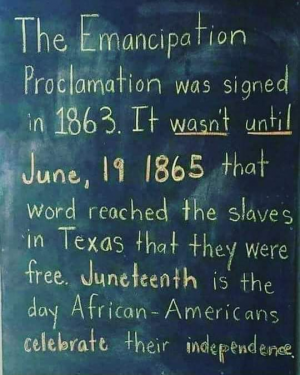Today is Juneteenth, a holiday celebrating the end of slavery in the United States. Not to be confused with the Emancipation Proclamation, which was issued Jan. 1, 1863, by President Abraham Lincoln, Juneteenth was born in Texas two and a half years later.
So why the delay? Well, news traveled slowly to the Lone Star State. Slaveowners in Mississippi, Louisiana, and other eastern states capitalized on that fact and migrated to Texas once they saw the writing on the wall. Some accounts put the number of enslaved Black people who were moved west after the capture of New Orleans in 1862 at more than 150,000.
It wasn’t until June 19, 1865, that Union soldiers led by Maj. Gen Gordon Granger arrived in Galveston with news that the Civil War had ended and along with it, slavery. On that day, Granger stood on the balcony of the Ashton Villa in Galveston and issued the following order:
“The people of Texas are informed that, in accordance with a proclamation from the Executive of the United States, all slaves are free. This involves an absolute equality of personal rights and rights of property between former masters and slaves, and the connection heretofore existing between them becomes that between employer and hired labor. The freedmen are advised to remain quietly at their present homes, and work for wages. They are informed that they will not be allowed to collect at military posts, and that they will not be supported in idleness either there or elsewhere.”
But even then, many enslaved Blacks remained unfree as masters waited until after the harvest to tell them. And many enslaved Black people who left the plantation were shot or lynched. Yet June 19 was a date to rally around and by 1866, Black people who were freed from slavery began celebrating Juneteenth with prayer, readings of the Emancipation Proclamation, and barbecues. They also dressed in their finest, something they were banned from doing prior.
They were still met with resistance in many cases where they were barred from using public property for their festivities and found themselves in rural areas or on church grounds. Eventually, African Americans became landowners and some donated land to be dedicated to the holiday, such as Emancipation Park in Houston, which was purchased from fundraising efforts by the Rev. Jack Yates.
Juneteenth celebrations waned in the early 1900s as classroom textbooks marked Jan. 1, 1863, as the date ending slavery and omitted references to Granger’s order of 1865. The Depression added to the holiday’s decline as people moved from farms into cities to work for employers who refused to grant leaves if the holiday fell on a weekday.
But the Civil Rights movement of the ’50s and ’60s reinvigorated the holiday and on Jan. 1, 1980, Juneteenth became an official state holiday in Texas. Since then, the District of Columbia and more than 40 other states including Arizona have followed suit recognizing Juneteenth as a state holiday or holiday observance. Gov. Doug Ducey wrote the holiday into law in 2016, The Arizona Republic reported.
Juneteenth was celebrated June 15 at Eastlake Park in Phoenix. The day featured African American live performances, cultural cuisine, art displays, forums, a children’s zone with arts and crafts, and plenty of vendors.
To learn more about the history of Juneteenth, go to https://www.pbs.org/wnet/african-americans-many-rivers-to-cross/history/what-is-juneteenth/.
